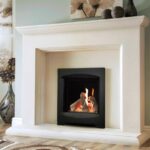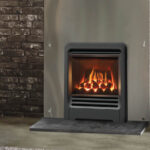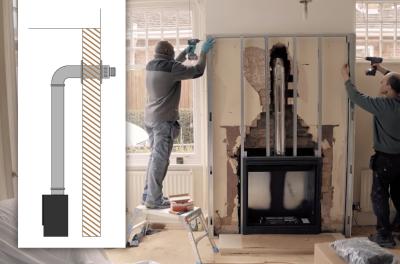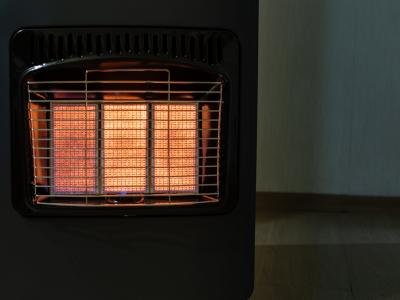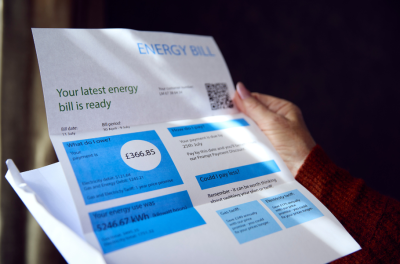We use cookies to improve your experience and our business. See our privacy/cookie policy or continue browsing to accept our use of cookies. View our cookie policy.
How Do You Calculate How Efficient a Fireplace Is?
If you’re looking to improve or upgrade your fireplace, one of the most important things you’ll need to work out is how efficient your chosen fireplace or appliance is. To help you do this, Direct Fireplaces has created a complete guide to calculating the efficiency of a fire.
Why should you figure out the efficiency of your fireplace?
We know that looking at things like efficiency, heat output and other details can be a bit tedious, but it really is worth going to the effort of calculating the efficiency of fireplaces when you’re selecting one.
Energy prices are set to rise over the coming years as the Government seeks to meet net zero carbon emissions targets. This means that if you haven’t got a particularly efficient fireplace, your wallet could be in trouble in the coming years!
So, whether you want a gas, electric or solid-fuel burning fireplace, take the time to work out its efficiency before you buy,
What does efficiency mean?
In the context of a fireplace, what do we mean by efficiency?
When we talk about efficiency we are referring to how much of the heat generated by a fire goes into heating a room - compared to how much heat is wasted.
Based on this principle, the efficiency of a fire will generally be presented as a percentage.
So, for example, if a fire is labelled as being 80% efficient, this means that 80% of the heat generated by the fire will heat the room in which the fire is situated. The remaining 20% will be ‘wasted heat’.
How is heat wasted?
At this point you might be wondering how heat is ‘wasted’. Surely when a fire burns firewood or gas etc, all of that heat is projected into the room?
Unfortunately not.
Whilst a block of firewood or a cubic metre of gas will contain a certain amount of potential energy, some of this energy is used in the process of ignition and maintaining combustion.
Some of this potential energy will also go up the chimney or out of the flue - and is therefore lost or ‘wasted’.

How do you calculate the efficiency of a fireplace?
So, with those fundamental principles in mind, what’s the formula that will help you calculate the efficiency of a fireplace?
To work out the efficiency of a fireplace, simply use the following formula:
efficiency = input / output
You then multiply the result of this formula by 100 to arrive at a percentage.
On many fireplaces this formula is represented by heat input divided by heat output. These two figures are normally presented as kilowatts (kW).
Tip - if you don’t want to use this formula, or are unable to obtain the heat input or output figures for a fireplace, you may be able to find the fireplace’s efficiency by looking at its specification sheet, product description or by contacting the manufacturer.
How to find the efficiency of a fireplace
Here at Direct Fireplaces we understand that not everyone is going to have the time or inclination to work out the efficiency of a fireplace. So, where possible, we’ve done the hard work for you.
Simply click on the fireplace of your choice, and then click on the Specifications tab as highlighted below:
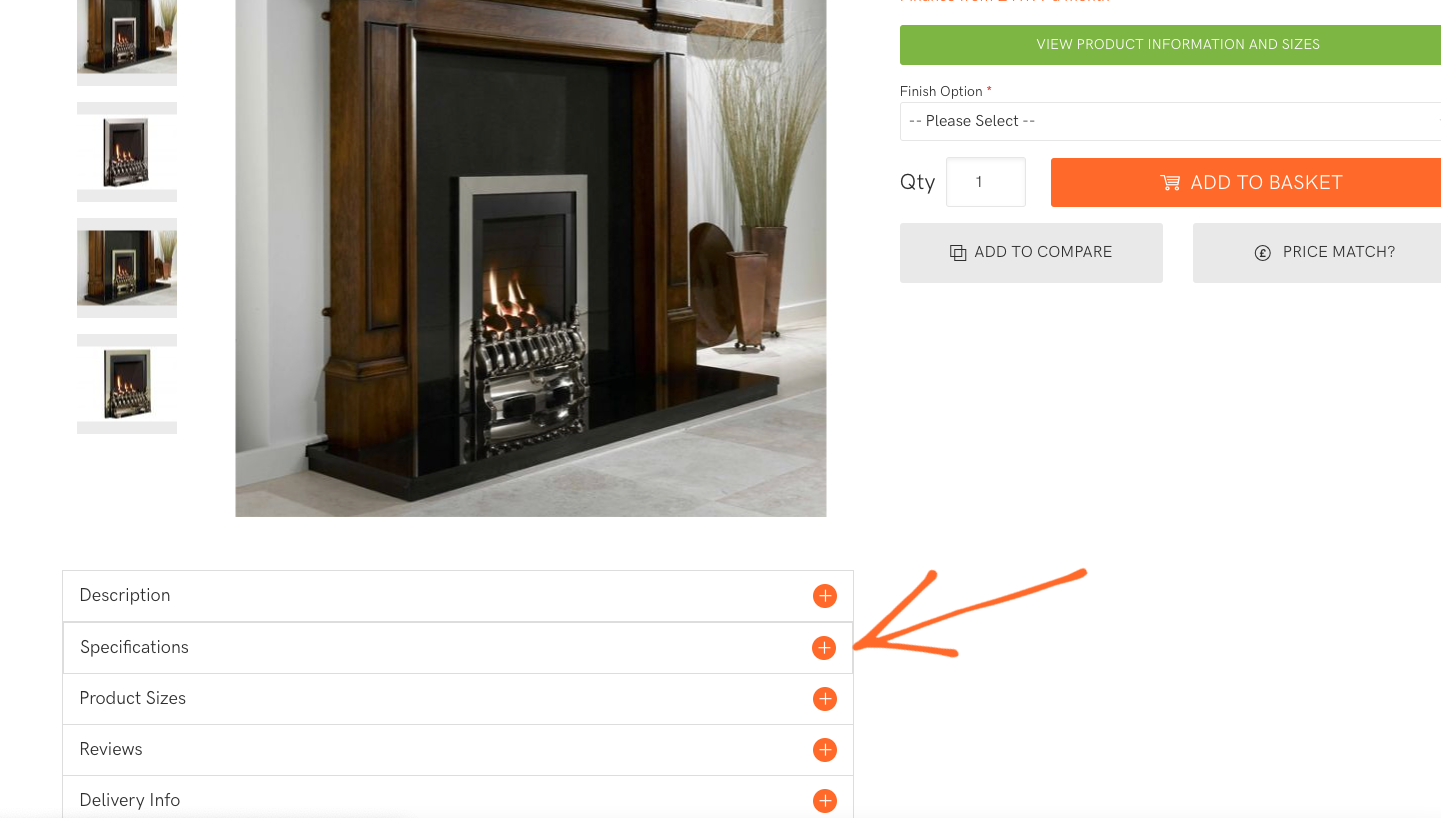
Once you’ve clicked on the specifications tab, this will expand to reveal a table. Within this table you’ll usually find the efficiency figure for the fireplace:
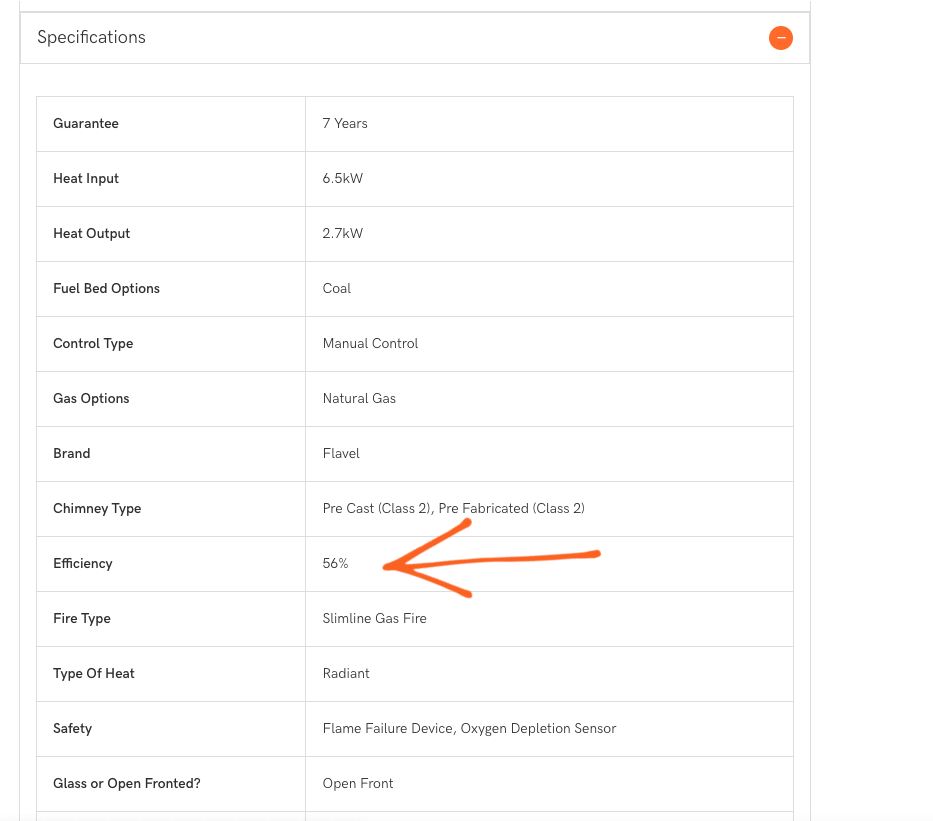
It’s important to note that not all fireplaces or appliances will show an efficiency figure. Which brings us onto our next point…
The efficiency of different types of fireplaces
When it comes to efficiency, not all types of fire were created equal. Whilst every individual type of fire will have its own efficiency rating, there are some general average figures that apply to each general type of fire:
- Open fireplace - if you’ve got a large open fireplace on which you burn solid fuels such as wood or coal, how efficient do you think it is? If you guessed between 5 and 15% then you’re correct! Unfortunately, open fireplaces - because of the way they operate and their construction - are notoriously inefficient. According to the Environmental Protection Agency, up to 90% of a wood burning open fireplace’s heat can be lost up the chimney.
- Gas fireplaces - gas fireplaces are considerably more efficient. Depending on what type of gas fireplace you buy, you could achieve as much as 90%+ efficiency
- Electric fireplaces - electric fireplaces offer the ultimate in efficiency. Because of the way they operate, electric fireplaces are able to convert 100% of their energy into heat. Because they aren’t burning fuel, none of the energy they receive is wasted on the process of ignition or combustion.
As you can see, the type of fireplace you choose can have a big impact on the ongoing cost of running your fireplace.
The more efficient your fireplace, the less time you’ll have to run it in order to heat up your room.
But, if you want to try and work out exactly how much a fireplace will cost you to run over the long term, then you’ll need to figure out the running cost of your fireplace.
How to calculate the running cost of a fireplace
So, you’ve selected an uber efficient fireplace - great! You know it’ll save you money over the long term; but how much money?
To figure out the cost of running a fireplace, you should begin by finding the following pieces of information:
- Find the heat input of your chosen fireplace. This will be displayed in kW. You can normally find the heat input of the fireplace on the product description page, the specification sheet or via the manufacturer.
- Figure out your estimated usage time each day. For example, you may use your fire for an hour in the morning and two hours of an evening. Add these up. That’s 3 hours per day.
- Determine the cost of your energy in pence per kilowatt (kW). Your energy bill (either electric or gas) should provide you with this number.
With these pieces of information to hand, you then want to use the following formula to calculate the running cost of your fire:
energy input (kW) x hours used = kWh (Kilowatt Hours)
Then:
kWh x cost of your energy in pence per kilowatt
Take this figure and then divide it by 100. This will give you the running cost of your fireplace in a ‘£0.00’ format.
Use our Fireplace Running Cost Calculator
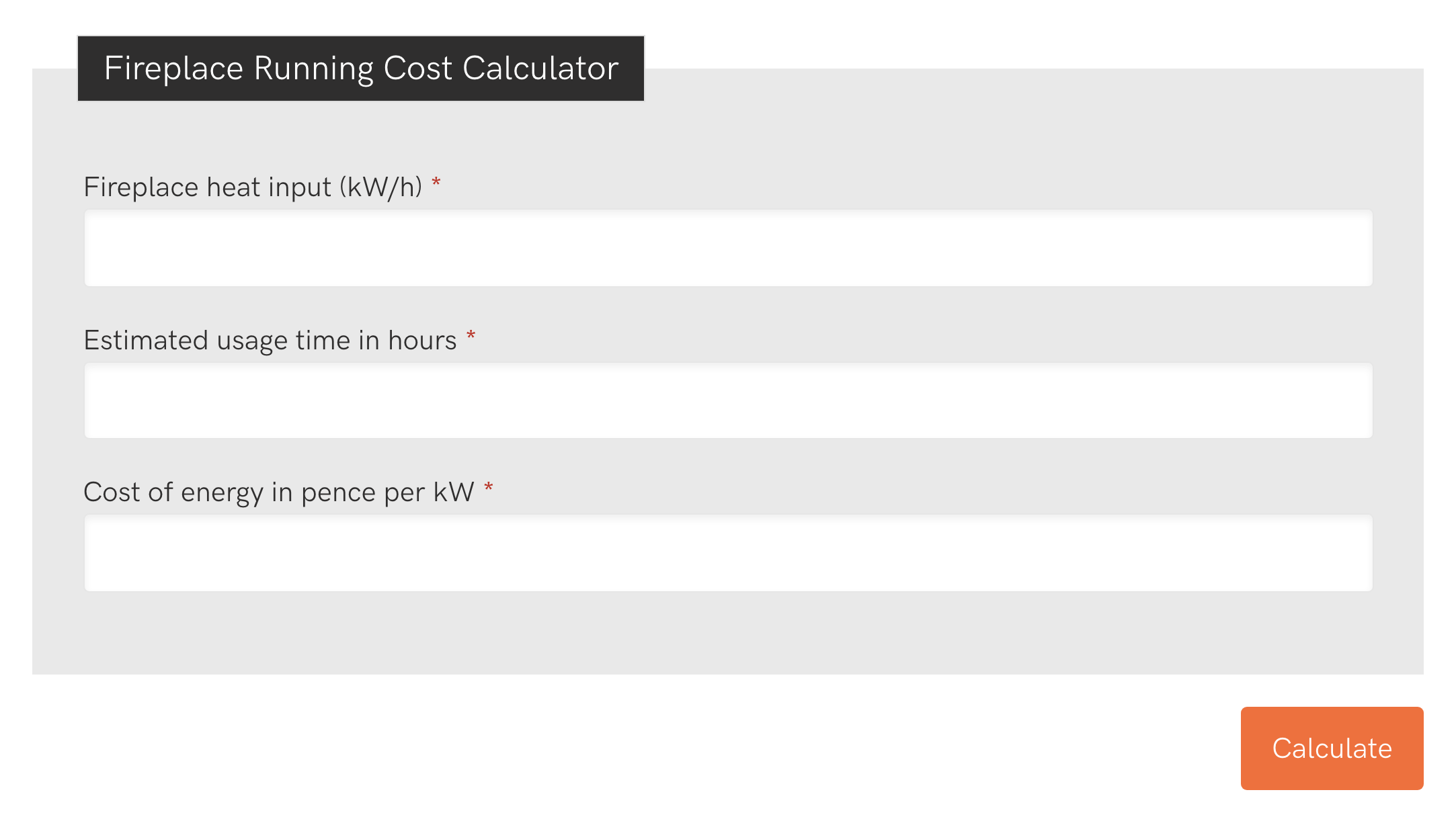
If you’d rather someone else took care of the calculations for you, then simply take the information you’ve got and input it into Direct Fireplaces’ Fireplace Running Cost Calculator. You’ll quickly get an idea of how much it will cost to run your chosen gas or electric fireplace!
The efficiency of gas fires
Okay, so now it’s time to look at a selection of gas fires and see how efficient they are.
Unlike electric fires, which are generally all 100% efficient, the efficiency of gas fires varies considerably depending on what type it is.
There are three main types of gas fire:
- Natural vent gas fires.
- Direct vent gas fires.
- Ventless gas fires.
We’ve provided a brief overview of each type below.
Natural vent gas fires
Natural vent gas fires operate in the following way; they vent waste air externally via a balanced flue (this usually protrudes from an exterior wall of your home) or a chimney, and they suck in fresh air to feed the fire from the room in which they are situated.
However, because they vent waste air externally either via a balanced flue or a chimney they lose heat and are therefore less efficient. Natural vent gas fires tend to have an efficiency rating of between 50 to 60%, but of course this will vary between individual models.
Direct vent gas fires
In comparison to natural vent gas fires, direct vent gas fires not only vent waste air externally, but also draw in fresh air from outside of your home. Direct vent gas fires feature a sealed glass door, which prevents leaks of combustion products into the room. These types of fires are therefore a kind of ‘closed’ loop whereby fresh air and waste air can be cycled very efficiently through the fireplace.
The ‘sealed’ nature of direct vent gas fires means they are very efficient. You can expect a direct vent gas fire to have an efficiency rating of between 70 and 80% (these figures can vary more from model to model).
Ventless gas fires
Ventless gas fires are undoubtedly the most efficient form of gas fireplace. As their name implies, ventless gas fires don’t feature any form of external venting. This means that any waste gases generated by the fire have to be vented directly into the room in which the fire is situated.
This means that ventless gas fires are designed to burn gas as efficiently as possible, so that no harmful by-products are generated. As a result, ventless gas fires are over 99% efficient. In fact, ventless gas fires are so efficient that they often don’t even include an efficiency rating as part of their product specification.
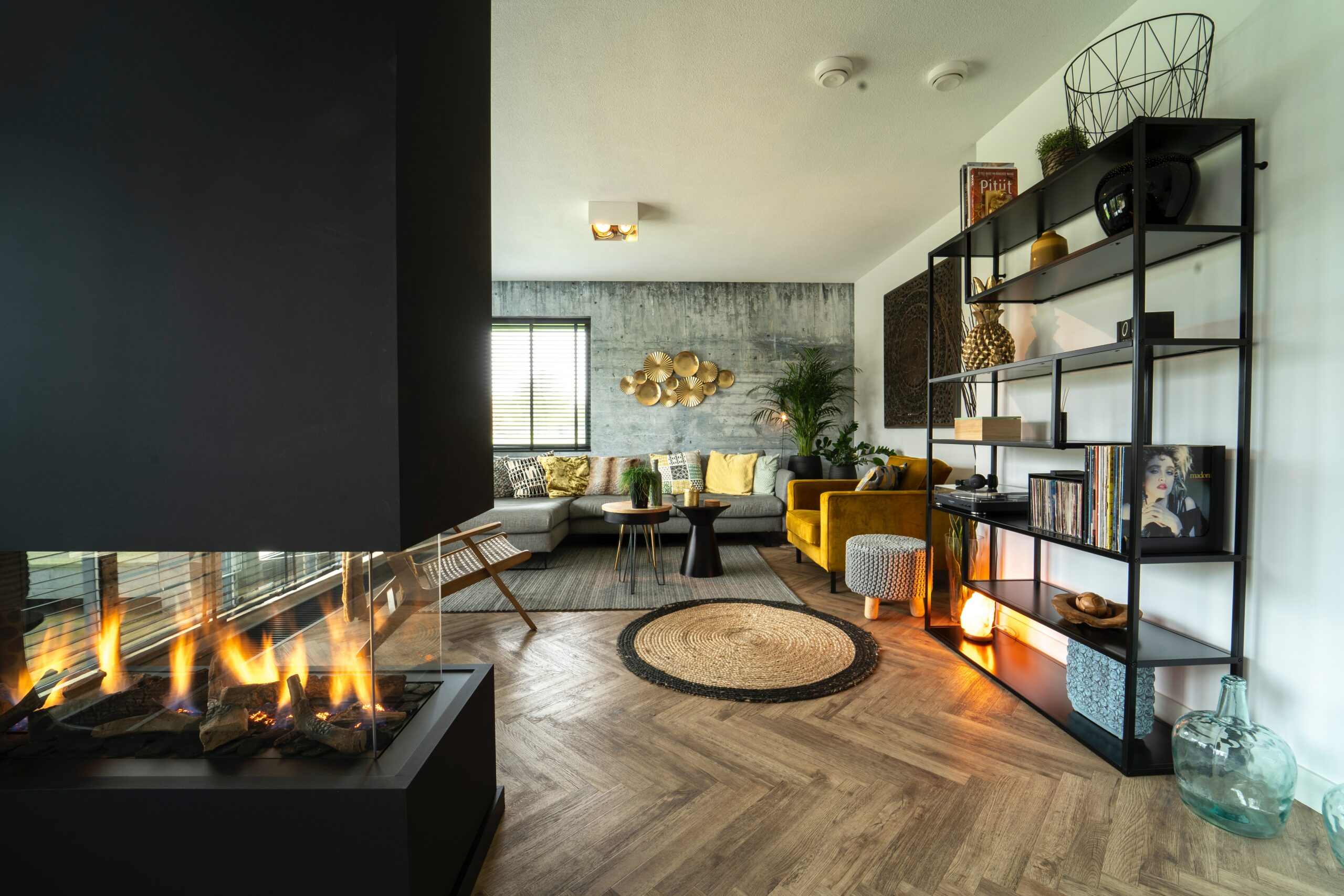
The efficiency of electric fires
As you’ve probably already gathered, electric fires are incredibly efficient - well, 100% efficient actually.
This is because they are able to use all of the energy that’s fed into them - none of the potential energy is lost through processes such as combustion or venting.
However, it’s important to note that some electric fires will be slightly cheaper to run than others. This is largely down to one thing; thermostatic control
Electric fires and thermostatic control
Electric fires that incorporate a thermostatic control can be cheaper to run than electric fires without one.
Why? Because a thermostat helps to regulate the temperature of a room. Once you’ve set the thermostat to maintain a particular temperature, it will turn the electric fire on and off as necessary to maintain that ‘target’ temperature in the room.
This means that your electric fire will only be on when required (rather than just being continuously on if it doesn’t have a thermostat). This means that the cost of running an electric fire with a thermostat will generally be less than running an electric fireplace without one.
A note on wattage and scale
The heat output of electric fires is measured in kilowatts (kWh). There is a bit of a misconception floating around the internet that the higher the kilowatts of an electric fire, the less efficient it will be.
This isn’t true.
An electric fireplace with a high kWh figure will use more electricity than a lower kWh electric fireplace, but it will generate more heat.
It will still be 100% efficient, as it’s using 100% of the energy it has received to generate heat - it’s just doing so at a larger scale than a smaller electric fire.
The most efficient fireplaces available right now
If you’ve made it this far, then you really must be serious about getting an efficient fireplace for your home!
Well, don’t worry. Choosing an efficient fireplace (be it gas or electric) doesn’t mean you have to sacrifice style, looks or functionality. Here at Direct Fireplaces we stock a massive range of high-efficiency fireplaces that’ll save you money, whilst also looking amazing.
Below we’ve set out some of our most popular high efficiency gas fires and electric fireplaces.
High efficiency gas fires
We’ll begin our look at the most popular efficient fireplaces by looking at high-efficiency gas fires. Gas remains the most popular type of fireplace, so you’ll find a huge range of choice and types on the market. Keep reading to discover some of our most popular high-efficiency gas fires.
Flavel Windsor Contemporary Plus HE Gas Fire
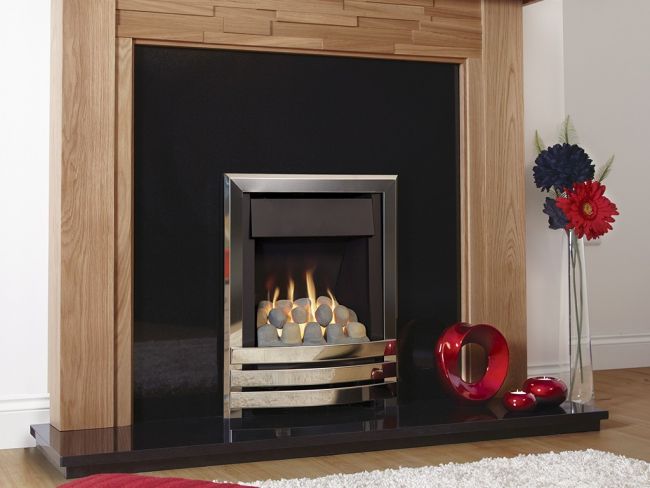
Flavel Windsor Contemporary Plus HE Gas Fire
The Windsor Plus High-Efficiency Gas Fire from Flavel is a fantastic, modern-looking gas fire. It features a 4.1kW heat output which means it’s more than capable of heating a good sized living room. Plus, with an efficiency rating of 66.8%, the Flavel Windsor is good for your wallet as well as your home!
Verine Frontier High Efficiency Gas Fire
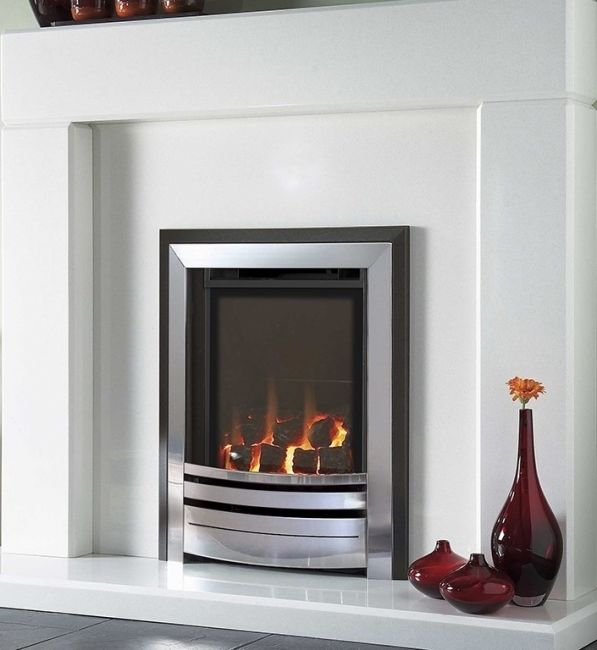
Verine Frontier High Efficiency Gas Fire
With a whopping 78% efficiency rating, the glass-fronted Verine Frontier offers fantastic value for money. Using only 4.5kW of gas to produce a heat output of 3.2kW, this fireplace will have low long-term running costs.
The Verine Frontier is available in a range of finishes, so it’s easy to match it with your home decor. It also features manual control, however there is also the option of upgrading to a remote control so you can control the fire from the comfort of your armchair or sofa.
Elgin & Hall Chollerton 22” Inset Gas Fire with Cast Stove Fascia

Elgin & Hall Chollerton 22" Inset Gas Fire with Cast Stove Fascia
Combining traditional looks, with a cutting-edge efficiency rating of 86%, the Elgin & Hall Chollerton is an unusual, yet charming gas fire.
Thanks to its cast stove fascia, the Elgin & Hall Chollerton allows you to experience the look and feel of a real stove, but with none of the drawbacks or inconveniences associated with traditional wood-burning appliances. It also has a 4.2kW heat output, so you certainly won’t be chilly when this fire is on!
High efficiency electric fires
Yes, all electric fires are high-efficiency, but we wanted to showcase some of our favourite and most popular models here. We particularly wanted to showcase those models that feature thermostat control, as this can reduce the long-term running costs associated with running a fire.
Flare Abbey Arched Inset Electric Fire
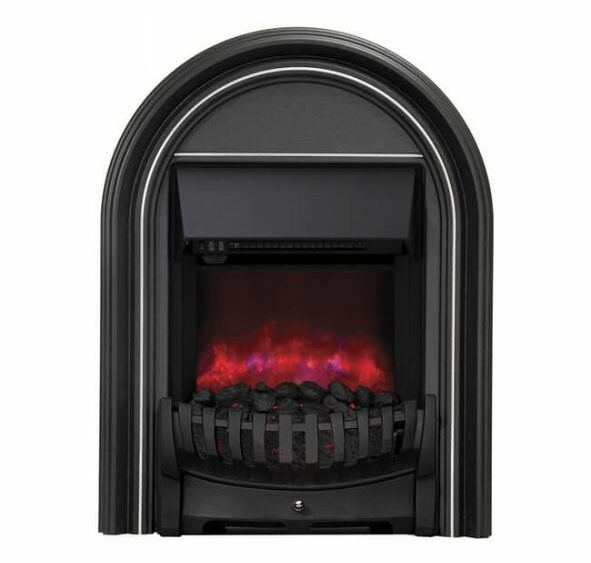
Flare Abbey Arched Inset Electric Fire
Combining traditional design with modern technology, the Flare Abbey features a cast-iron style design, but in a compact and easy-to-use package.
The Abbey features a stunning realistic flame effect that uses LED bulbs which provide lower energy consumption and longer life.
Flare Aspen Inset Electric Fire

Flare Aspen Inset Electric Fire
A classic inset fire, the Flare Aspen features a 2kW heater along with a beautiful flame effect which mimics the look and feel of a real fire.
The flame effect also has the benefit of being able to be used independently from the heating element - so if you’ve got the central heating on, but still want the illusion of flames in a fireplace - the Flare Aspen will allow you to do just that.
Flare Vitesse Inset Electric Fire

Flare Vitesse Inset Electric Fire
A sleek, contemporary looking fire, the Flare Vitesse is a super efficient fire that’s certainly not economical on looks.
Featuring a realistic coal fuel effect bed, a heat output of 2kW, and high-level side switches for easy control, the Flare Vitesse is a fantastic value electric fireplace that packs in the features.
Thanks to its inset design, the Flare Vitesse doesn’t require a chimney or recess in the wall, so it’s a great option for new build homes.
Time for an efficiency upgrade?
If you’re warily watching those energy bills getting larger and larger, perhaps it’s time to upgrade to a high-efficiency gas or electric fireplace? A single investment up front can save you thousands in the long term thanks to reduced energy bills, high-efficiency (meaning you don’t have to put the fire on as long) and much more.
Shop high-efficiency fires at Direct Fireplaces today
Read more fireplace advice and guidance on the Direct Fireplaces blog…
Which Gas Fires Are the Most Efficient? | Which Electric Fireplace Gives the Most Heat? | What Types of Fires Can You Use in a Media Wall?
[related_products is_auto_added="1"]admin
Latest posts by admin (see all)
- Electric Fireplace Inserts Buying Guide - March 27, 2023
- What Types of Flueless Fires Are There? - February 23, 2023
- What Are the Best Contemporary Gas Fires? - January 17, 2023


